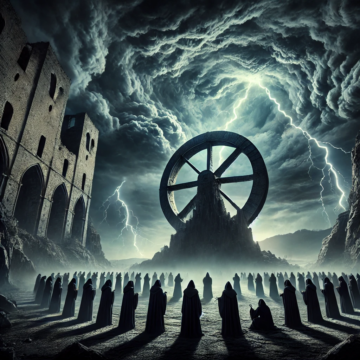by Steve Szilagyi

Those first eight thunderous notes—”Oh Fortuna, velut Luna”—delivered by a massive choir of a hundred voices, have become as instantly recognizable as Beethoven’s da-dah-dah-DUM or the opening of Strauss’ Also Sprach Zarathustra. Since John Boorman first deployed O Fortuna in his 1981 film Excalibur, this choral juggernaut has stampeded through many horror films, parodies, videos, and cartoons—always to soul-chilling effect.
There’s no denying O Fortuna’s raw power. The chanting choir, the pounding drums, the ascending shrillness of the voices: it creates the unsettling sensation that an army of insane monks is closing in on you from the dark corners of a satanic cathedral. It is the musical embodiment of the Burkean sublime: an encounter with vast, uncontrollable, and terrifying forces.
This two-minute masterpiece by German composer Carl Orff, which opens and closes his 1936 “scenic cantata” Carmina Burana, has made the entire 60-minute work into one of the more frequently performed pieces of classical music worldwide. Dozens of professional, academic, and community music groups across America will stage it this year—no small feat considering the orchestra size and number of singers required. For symphony orchestras and concert halls, Carmina Burana has become a reliable cash cow, more valuable than many other popular favorites because it attracts that rarest and most coveted entity in the classical music world: the under age-65 audience.
Rocky Horror. These youthful attendees make a livelier impression than the usual classical crowd. Since Carmina Burana is based on Medieval texts, some fans show up in Renaissance Fair costume. Others don top hats, capes, and Morticia Adams-style gowns to properly absorb O Fortuna’s chills. The piece may eventually become the Rocky Horror Picture Show of classical music.
But as these eager young listeners soon discover, once O Fortuna’s echoes fade, the fun stops. Right after O Fortuna, there’s another musical movement, Fortune plango vulnera (I lament the wounds of fortune). This number is almost as pounding and chant-like as O Fortuna, but not as scary. And once that’s over, there are still 2o or so musical movements to go, and Carmina Burana begins its dramatic descent into sad tedium.
The wandering scholars and moth-eaten clerics who composed the 20-some poems forming Carmina Burana’s text wrote about all sorts of lively topics: drunkenness, carnal lust, religious hypocrisy, gambling, springtime and nature, as well as the wheel of fortune. Even a modestly talented Broadway composer could have fashioned more than one hit out of this material. But after O Fortuna struts its stuff, the rest of Carmina Burana is filler.
At concert performances, you can observe the audience’s reaction to the grim reality of Carmina Burana as it unfolds. The expressions of terrified rapture that greet O Fortuna’s opening notes lose their glow about 20 minutes in. That’s when listeners realize that this isn’t getting any better, Carl Orff is no entertainer, and there’s still a long 40 minutes ahead.

Pagan fantasies. In Orff’s defense, he didn’t intend for Carmina Burana to be the static concert piece it is today. At its premiere, it was part of a complete stage presentation with costumes and scenery, every musical passage corresponding to an action on stage.
Since that 1936 opening night crowd greeted the piece rapturously, I have to assume the costumes and scenery were really something. Indeed, modern dance companies have used Carmina Burana as an excuse to don tight or revealing outfits and act out lascivious pagan fantasies – all to the good, I say.
Orff had a theory that music should be “elemental,” with simple rhythms following speech patterns. In Carmina Burana, these simple rhythms manifest as insistent pounding—bass drum and timpani going bam, bam, bam.
Igor Stravinsky, who practically invented orchestral bam-bam-bam in his 1913 Rite of Spring, loathed Carmina Burana, dismissing it as a “collection of clichés.” In the rare moments when the drums cease, there are some charming woodwind passages and opportunities for vocal soloists to shine—though perhaps these sections seem pleasant merely because they offer a break in the percussive assault.
Hungover. Halfway through, Carmina Burana novices might consult their programs and discover a tavern scene and drinking song approaching. “This should be good,” they think, since by operatic convention, drinking songs are rousing, melodic pieces that you hum on the way out of the theater. But Orff denies us even this simple pleasure. His drinking song is slow and lurching – hangover music.
Orff isn’t entirely devoid of some crude show-business savvy, however. Just as Carmina Burana nears its conclusion, when the audience has mentally checked out like corporate managers during a lengthy PowerPoint, he resurrects O Fortuna, jolting everyone awake and reminding them why they came. After its final notes, there are cheers, standing ovations, and everyone leaves—glad to have heard a piece of concert music that is validated by pop cultural reference, and glad that it is over.
No stuffy. Chatting once with an orchestra administrator, I mentioned my regret about Carmina Burana’s frequent programming. She quickly put me in my place: “Anything that gets young people into the concert hall is good,” she said. “It shows them this is a welcoming environment. We’re not stuffy, and they can enjoy themselves here. If they have a good experience at Carmina Burana, they might buy tickets for better music to see what it’s like.”
She was right, of course. My hope is that the Carmina Burana crowd gets older and more discerning, they’ll discover they can experience all the thrills and chills of O Fortuna – and so much more – in works that are more musically ambitious, spiritually transcendent, and emotionally involving.

I recognize that not everyone is in the market for transcendence. For many listeners, Carmina Burana’s bleak nihilism is at the heart of its appeal. An inescapable fact about western classical music is that many of its most beautiful and elevating works were written by deeply Christian composers for Christian audiences, incorporating biblical themes and liturgical structures. Couples going out for a night of culture don’t necessarily want to be reminded of God and the annoying possibility that he might exist.
They’re missing some great stuff. Wolfgang Mozart’s Requiem in D Minor is a rip-roaring choral mass that crushes Carmina Burana on every level: thrilling music, emotional dynamics, tenderness, and terror.
Mozart’s God makes his appearance in the Requiem’s big number, Dies Irae (Day of Wrath), based on the Gregorian chant of the same name. Dies Irae might well be regarded as religion’s answer to O Fortuna. Not only Mozart but Giuseppe Verdi and Hector Berlioz have created thunderous, doom-laden settings of this text. And like O Fortuna, it has been used in films ranging from X-Men to Django Unchained when directors want to shake audiences to their core. Unlike O Fortuna which frightens us with a mere cosmic void, Dies Irae dangles listeners over the flaming pits of Gehenna.
O Hallelujah. If there is a full-scale anti-Carmina Burana, it’s that other orchestral cash cow, George Friedrich Handel’s Messiah. The bam, bam, bam in Messiah is the sound of one brilliant aria hitting right after another, each with a different mood — subtle, majestic, blustering, questioning. Messiah also features a popular, spine-tingling choral masterpiece that has become a musical cliche. But unlike Orff, who bookended his otherwise dull work with its most rousing number, Handel has his Hallelujah Chorus pop up right in the middle, where it fills listeners’ minds and spirits with almost frightening exaltation before transitioning to the quiet, achingly lovely I Know That My Redeemer Liveth. That’s a composer who knows how to work an audience. I know … is followed another twenty minutes of magnificent arias—any one of which you might carry home in your head.
It’s safe to say that without O Fortuna, few people would ever sit through a performance of Carmina Burana. But would Messiah still be popular without the Hallelujah Chorus? Hell yes.
Carmina Burana’s chants shrivel in comparison to choral music by composers who believed that there was something eternal at stake in the music they wrote and texts they selected. You needn’t share their beliefs to recognize that the emotions behind the music are genuine—joy and suffering exist, life is important, and redemption, in some form or another, is possible in this world.
Oh this hateful life. Every summer, my local orchestra closes up their urban concert hall, and retires to the countryside, where they perform in a vast outdoor amphitheater —a soaring roofed structure surrounded by woods and rolling hillsides. Checking their schedule recently, I noted Carmina Burana, plopped right down in the middle of July – glorious high summer.
Carmina Burana will undoubtedly sell out all 6,000 seats and every patch of ground on the surrounding hills. The sun will set over the treetops, a gentle breeze will ripple through nearby cornfields, stars will emerge, and a younger-than-usual orchestra crowd will hear from a hundred voices, ringing out over the cheerful countryside:
Vita detestabilis…
Sors immanis
Et inanis,
Rota tu volubilis
Status alus
Vana salus
Semper dissolubilis…
(Hateful life… Fate—monstrous and empty, you whirling wheel, you are malevolent, well-being is in vain and always fades to nothing…)
Bam, Bam, Bam.
***
Enjoying the content on 3QD? Help keep us going by donating now.
